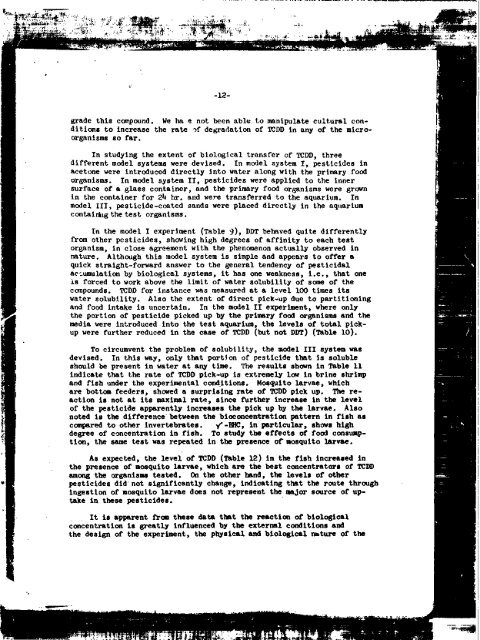Item ID Number - Special Collections
Item ID Number - Special Collections
Item ID Number - Special Collections
You also want an ePaper? Increase the reach of your titles
YUMPU automatically turns print PDFs into web optimized ePapers that Google loves.
-12-<br />
grade this compound. We ha e not been able to manipulate cultural conditions<br />
to increase the rate of degradation of TCDD in any of the microorganisms<br />
so far.<br />
In studying the extent of biological transfer of TCDD, three<br />
different model systems were devised. In model system I, pesticides in<br />
acetone were introduced directly into water along with the primary food<br />
organisms. In model system II, pesticides were applied to the inner<br />
surface of a glass container, and the primary food organisms were grown<br />
in the container for 2k hr. and were transferred to the aquarium. In<br />
model III, pesticide-coated sands were placed directly in the aquarium<br />
contairAig the test organisms.<br />
In the model I experiment (Table 9), DDT behaved quite differently<br />
from other pesticides, showing high degrees of affinity to each test<br />
organism, in close agreement with the phenomenon actually observed in<br />
nature. Although this model system is simple and appears to offer a<br />
quick straight-forward answer to the general tendency of pesticidal<br />
accumulation by biological systems, it has one weakness, i.e., that one<br />
is forced to work above the limit of water solubility of some of the<br />
compounds. TCDD for instance was measured at a level 100 times its<br />
water solubility. Also the extent of direct pick-up due to partitioning<br />
and food intake is uncertain. In the model II experiment, where only<br />
the portion of pesticide picked up by the primary food organisms and the<br />
media were introduced into the test aquarium, the levels of total pickup<br />
were further reduced in the case of TCDD (but not DDT) (Table 10).<br />
To circumvent the problem of solubility, the model III system was<br />
devised. In this way, only that portion of pesticide that is soluble<br />
should be present in water at any time. The results shown in Table 11<br />
indicate that the rate of TCDD pick-up is extremely low in brine shrimp<br />
and fish under the experimental conditions. Mosquito larvae, which<br />
are bottom feeders, showed a surprising rate of TCDD pick up. The reaction<br />
is not at its maximal rate, since further increase in the level<br />
of the pesticide apparently increases the pick up by the larvae. Also<br />
noted is the difference between the bioconcentration pattern in fish as<br />
compared to other invertebrates. y-HHC, in particular, shows high<br />
degree of concentration in fish. To study the effects of food consumption,<br />
the same test was repeated in the presence or mosquito larvae.<br />
As expected, the level of TCDD (Table 12) in the fish increased in<br />
the presence of mosquito larvae, which are the best concentrators of TCDD<br />
among the organisms tested. On the other hand, the levels of other<br />
pesticides did not significantly change, indicating that the route through<br />
ingestion of mosquito larvae does not represent the major source of uptake<br />
in these pesticides.<br />
It is apparent from these data that the reaction of biological<br />
concentration is greatly influenced by the external conditions and<br />
the design of the experiment, the physical and biological nature of the
















